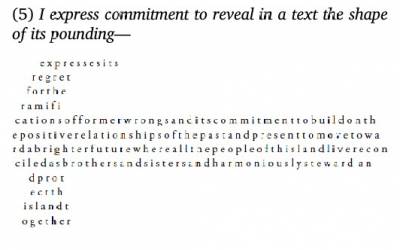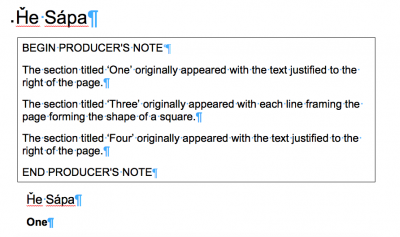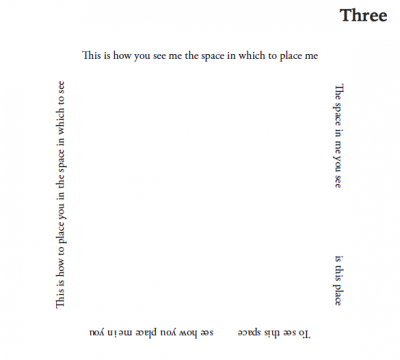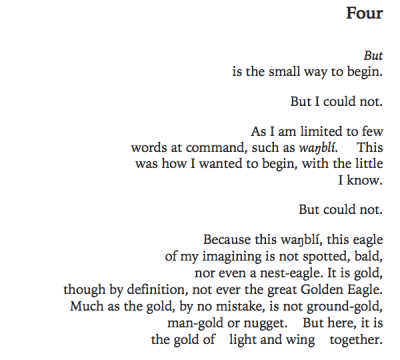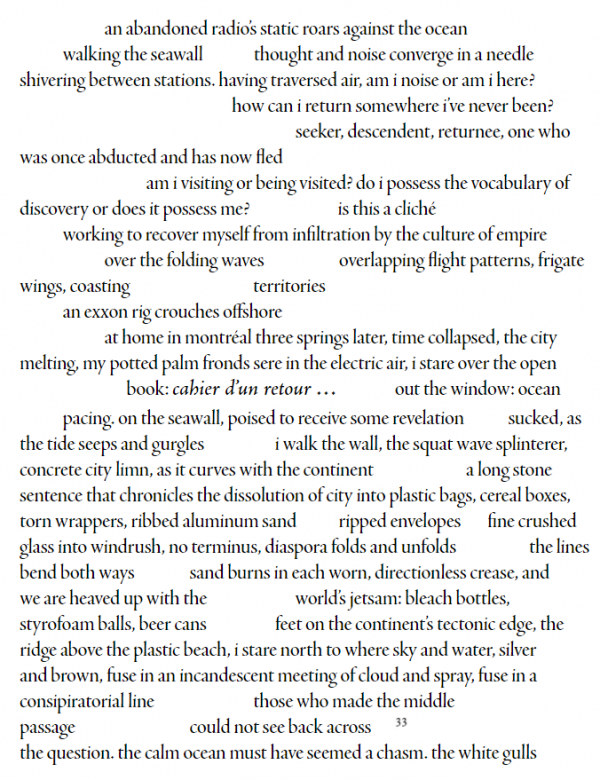This is an old revision of the document!
Table of Contents
Poetry
We mark up poetry differently than normal paragraph text. For Poetry, we apply the following DAISY Styles in Word:
- Poem (DAISY)
- Poem - Title (DAISY)
- Poem - Byline (DAISY)
- Author (DAISY)
By poetry, we mean any text where definition of poetic structure is required. The Poem (DAISY) style is an appropriate form of markup for song texts or lyrics.
Styles
Poem (DAISY)
The Poem (DAISY) style is used to wrap the entire poem, or fragment of a poem, in the <poem> tag and the lines of the poem in the <line> tags in XML.
The Poem (DAISY) style may also be used to mark up texts displaying elements of versification, metre and rhyme where the use of the Normal paragraph style is considered insufficiently accurate.
You must always apply the Poem (DAISY) style first, before you apply any of the Title, Author, or Byline styles.
Poem - Title (DAISY)
The Poem - Title (DAISY) style is used to wrap the title of the poem in the <title> tag in XML.
Example:
Title of Poem [Heading 1 Style]
Title of Poem [Poem - Title (DAISY)]
Poem - Byline (DAISY)
The Poem - Byline (DAISY) styles can be used to wrap information about the creator of, or contributor to, a work, usually consisting of more than just an author's name. A byline may not contain a name at all.
Author (DAISY)
The Author (DAISY) style can be used to wrap the author of the poem in the <author> tag in the XML. Only select the author's name and not other words, such as "by".
Poems in a foreign language
If the poem is in a foreign language, we can select the text and go to Tools > Language > Mark Selected Text As and select the relevant language of the text.
If only select individual words are in other languages, do not apply any language formatting. Simply make a note of this and include this note when you are done and transfer the ticket to the Production Coordinator via RT.
Complex Formatting and Producer's Notes
Sometimes you will come across a poem that has more complex formatting that can not be translated to DAISY.
We can not retain this formatting for DAISY conversion.
Common Types of Complex Formatting
The more common forms of complex formatting are:
- spacing,
- line justification,
- and concrete poetry.
In poetry the use of blank space on a page, between lines, words, or even letters, can be used to convey meaning. We can not retain blank spaces.
Lines, stanzas, or entire poems can use right justification to convey meaning. We can not retain right justification.
A Concrete poem is a poem where the words create a shape on the page that conveys a visual meaning. We can not retain the original shape of a concrete poem.
Example Original Poem:
In-Text Producer's Note Text:
BEGIN PRODUCER'S NOTE
In the section titled (5) the words after the first line originally appeared with no spaces and in the shape of a hammer. The poem has been reformatted to have spaces between the words, and without word breaks at the end of lines.
END PRODUCER'S NOTE
Images in Poems
Sometimes you will come across images of text in poems. This is a big no-no in publishing and not accessible. See the section on Images of Text for more.
We transcribe all images of text and mark up with the appropriate NNELS styles. If it was a case of complex formatting, then use an In-Text Producer's Note.
Sometimes you will find the poet has used an image of a black bar to signify the censorship of a word of phase. In this can you can keep the image and add the Alt-Text "Thick black bar blocking out word/phrase."
Producer's Note
In these cases include a Producer's Note at the beginning of the book.
Producer's Note [Heading Style 1]
This book originally appeared with special paragraph and line spaces that added to the meaning of the text. Due to the conversion process these design elements have been removed. For poems that originally appeared with more complex formatting there are in-text producer’s notes.
For more info please go to the Producer's Note page.
In-Text Producers Notes
If there are individual poems within a collection that have complex formatting you may have to also include In-Text Producer's Notes to explain the original formatting and how it has changed with conversion.
Always us the Prodnote - Optional (DAISY) for all poetry in-text producer's notes.
See In-Text Producer's Note for more information on usage and styling.
Below is an example from the book Whereas, by Layli Long Soldier. The title of the poem is 'He Sapa' that is broken down into sub-headings with each sub-section having special formatting in the original poem. The in-line Producer's Note is placed after the navigation title styled with Heading 1, and before the title styled with Poem - Title.
For more information on what elements can go within a poem's DAISY XML Structure please check out the DAISY 3 Structure Guidelines for Poetry.
Example Word and XML markup
Example 1
In Word, if we tag the text below with the Poem (DAISY) style…
aujourd’hui le temps a métallisé la neige et le silence s’est réjoui pour mieux se confondre des traits blancs se précipitent au sol des montagnes s’accrochent sur les écorces des arbres et sur des bras épineux les verts disparaissent les bleus deviennent opalescents les contours des bruns et des roux s’estompent par moments un oiseau tire un trait noir dans cet espace accéléré
… then this is the output we will get in XML:
<poem> <linegroup> <line>aujourd’hui</line> <line>le temps a métallisé la neige</line> <line>et le silence s’est réjoui</line> <line>pour mieux se confondre</line> <line>des traits blancs se précipitent au sol </line> <line>des montagnes s’accrochent</line> <line>sur les écorces des arbres et sur</line> <line>des bras épineux</line> <line>les verts disparaissent</line> <line>les bleus deviennent opalescents</line> <line>les contours des bruns et des roux</line> <line>’estompent</line> <line>par moments</line> <line>un oiseau tire un trait noir</line> <line>dans cet espace accéléré</line> </linegroup> </poem>
Example 2
In Word, if we tag the text below with the Poem (DAISY), the Poem - Title (DAISY), and the Author (DAISY) styles…
XXIX
When in disgrace with fortune and men's eyes
I all alone beweep my outcast state,</line>
And trouble deaf heaven with my bootless cries,
And look upon myself, and curse my fate
William Shakespeare
…then this is the output we will get in XML:
<poem>
<title>XXIX</title>
<linegroup>
<line>When in disgrace with fortune and men's eyes</line>
<line>I all alone beweep my outcast state,</line>
<line>And trouble deaf heaven with my bootless cries,</line>
<line>And look upon myself, and curse my fate</line>
</linegroup>
<author>William Shakespeare</author>
</poem>
Q&A
Q: Hi: another poetry question : ) This is regarding How to Dress a Fish. There is again a lot of complex formatting in the original text. However, I've come across something new in the second poem, "Fox Hunting". The sections of the poem with more complex formatting have been inserted as images instead of text. I'm wondering how you think I should handle this: should I transcribe the poems into text and delete the images (and lose most of the formatting), or should I keep the images and transcribe the text as a prod note?
Looking ahead, there is a mixture of text and images. A particularly complex one is the image for [grocery list, July 26, 2015]. I lean towards keeping the images and doing prod notes for them because of how complex and visual they are but I wanted to check what you thought.
A: I looked at the book, and this is a tricky one. Text as images is a big publisher no-no. We currently do not retain complex formatting for DAISY books.
For most of this collection you want to adhere to this and transcribe and remove all images of text except [Side 1] and [Side 2] in "Fox Hunting":
- First transcribe and markup the poem styles as per wiki standards
- insert a In-Text Producer's Note explaining what has been lost at the beginning of the poem,
- Keep the images and do an In-text Producer's note after the image describing the formatting.
- Enter simple Alt-text for image (e.g. Section of poem as originally formatted.)
Other formatting tasks for this book:
- retain italics, underline and strikethrough when they occur.
- For the lines and small decorative images that work as content breaks, replace them all with the asterisks.
- For the text boxes, use the wiki standards.
- Keep the black boxes and add the alt-text "thick black line that blocks out word"
For an example of another tricky book I recommend downloading 'Whereas' from our repository. If you have more questions about this one ask away!
Q: I am editing a book of poetry, Arias by Sharon Olds. One of the poems uses scansion marks to indicate syllable stress in the middle of the poem. How should I approach this to ensure it is read appropriately?
Here is the relevant part of the poem:
being the baby, being the mother, / - - / - , , / - - / - , dactyl, trochee, dactyl, trochee, active witness, active witness of the witness.
A: Leave it as is. You can mention in the Producers note at the beginning that the poem include scansion marks to indicate syllable stress.
Q: Follow up to the Magnetic Equator poetry question. I did read the section on complex poetry formatting before posting my question. The example says to use an inline prod note before each poem to describe the formatting. However, if you look at the poems in this book, their formatting is more variable and complex than the example so many of them would require a very long and hard to follow prod note because there's not a regular pattern to the odd spacing. After reading the wiki instructions, I wasn't sure that the instructions would work for these poems due to their complexity. I agree that inserting [space] interrupts the flow which is why I wasn't sure if this was any better and posted my question. So, just checking, is a prod note like this what you think I should do for each poem?:
BEGIN PRODUCER'S NOTE In the following poem, there is a blank page between each stanza. In the first stanza, the first line is center justified. The second line is indented and there is a space in between the word "seawall" and "thought". The fourth, fifth and seventh lines are right justified. On the eighth line, there is a large space between the words "me?" and "is". The ninth line is indented. The tenth line is right justified and has a large space between the words "waves" and "overlapping". The eleventh line has a large space between the words "coasting" and "territories". The twelfth line is indented. The thirteenth line is right justified. The fifteenth line is right justified and has a large space between the words "retour…" and "out". The sixteenth line is right justified and has a space between the words "revelation" and "sucked". The seventeenth line has a space between the words "gurgles" and "I". The eighteenth line has a space between the words "continent" and "a". The twentieth line has two spaces. One between "sand" and "ripped" and one between "envelopes" and "fine". The twenty-first line has a space between "unfolds" and "the". The twenty-second line has a space between "ways" and "sand". (Etc, etc). END PRODUCER'S NOTE
or would you recommend a simpler but less informative note like this:
BEGIN PRODUCER'S NOTE The following stanza has some lines that are right justified. It also has large spaces placed irregularly in the middle of lines. END PRODUCER'S NOTE
A: The simple version of the inline producer's note is best. We don't have to go into specific details on where the spacing is, just that we did not retain it. Example; "The following poem included spaces within the lines of the poem, as well as left and right justification of different lines and stanzas." or something similar.
Remember that an inline producer's note can only go before the title styled with Poem - Title (DAISY) and after the poem title in Heading style. This means each poem that has complex styling gets one note.
Most people will be reading the poetry for leisure so the producer’s notes are just to let people know formatting has been removed and maybe provide some general description on how it was originally formatted. If a reader requests a copy with original formatting or wants to know details about the original formatting then we can always do that a later date (that’s yet to happen.) Remember, a key rule of thumb to accessibility is keeping it simple.
Q: I am doing a book of poetry, Magnetic Equator, and the poems are formatted with unusual spaces and justification. I've attached samples screenshots of one of the poems, with a screenshot of how I'm trying to represent the original formatting. I also thought I'd put a prod note at the beginning explaining that spaces and right justification are marked throughout the poems to represent the original formatting. Please let me know if this works or if there's a better way to do this.
A: Though I see what you are attempting to do here, but it disrupts the reading of the text. We have a section on the wiki that explains how to produce complex poetry. Here is a direct link.
Q: Another poetry question: In the book Treaty #, on page 1, 33, and 63, there are a bunch of backwards words. They're English but they're spelled backwards. They also seem to be slightly out of order. I'm just wondering if you have any suggestions about how to handle this? Do you think I should just leave it as is? The backwards English words are so hard to read (which I think is the author's point) but people with print disabilities may not be able to access them at all this way. I'm wondering about inserting a second version with the words spelled normally but still out of order, with a producer's note explaining that in the original version, they are spelled backwards? Just for accessibility reasons.
A: In this case, leave it as is since it is the intent of the author to have it difficult or impossible to read. Insert a inline producer's not before the title of the poem explaining that the poem includes words that are backwards and out of order to intentionally create confusion for the reader.
Q: In the book of poetry I'm working on (St. Boniface Elegies), there are quite a few words marked with italics. On the page on poetry in the wiki, it says, "Sometimes certain styles can be retained within the poem, such as italics. If you are working with a poem with such formatting please contact us to advise how edit." So, could you let me know how I should handle the italics in this book?
A: You can retain the italics in the lines of poetry, but remove the italics from the titles, blockquotes, Acknowledgements, and About the Author. The italics in the poems themselves are there for emphasis, while all the other times it is just a visual stylistic choice that does not add meaning to the text and therefore not needed for conversion.
Q: Also relating to the book of poems (St. Boniface Elegies), I've come across a poem that is divided into sections and each section has a title. So essentially they are sub-titles and normally I would give them the next level of headings. But since this is poetry, I'm not sure how to handle them. Should I tag the sub-titles with the Poem - Title style? With the next level heading style? Or not tag them at all? The poem I'm referring to is called "downtown campus" in Part 1 of the book.
A: Keep them as Poem (DAISY), but retain the italics. You can also put an inline producers note to explain what you have done. The wiki has some examples of this in the poetry section. Poems are often a bit tricky, since they are both creative and we are limited by what we can do within the DAISY consortium standards for access. Hope that helps!
Q: I am editing a poetry book that uses Italian, French, and Latin. If I apply a language to one word, it changes the entire line or stanza. Should I just leave it as poetry style?
A: Unfortunately, identifying languages in Word doesn't translate well to DAISY XML and requires manual editing of language tags in the XML. You can just leave the Word version without language markup and use just the poetry style. Just make a note in the RT ticket that there are multiple languages.
